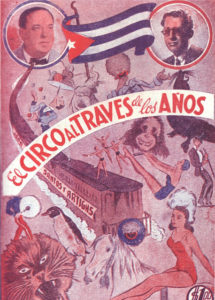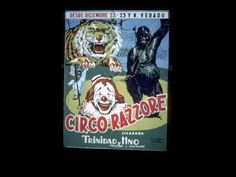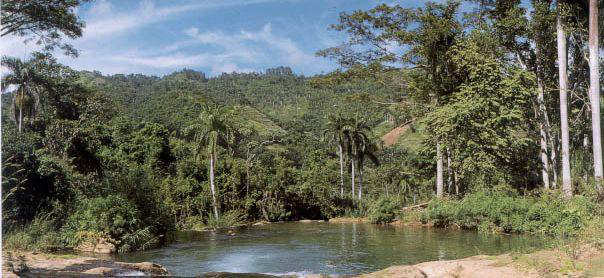That ancient art that is the circus, had interesting manifestations in Cuba. The poor circuses roamed the island and ended up placing their tent at the entrance or exit of a town or any wilderness that was within the urban area. Normally their tours were linked to the sugar harvest, with the agricultural workers and the sugar factories being the main assistants to the functions. Remember that the harvest lasted from November until the beginning of April, so that was the time of “fat cows” of traveling circuses.
At the end of the 19th century the Asturian, Manuel Pubillones groups all the circus art events and became the most important circus, although it would disappear in 1924 as a consequence of the little commercial ability of the heirs of its founder.
Previously the circus La Rosa, which had emerged in Camagüey and was considered a precursor of this art, had toured throughout the country.
Meanwhile in Matanzas Cirque Montalvo, created by two trapeze brothers, who were called “Los Carreteritos” because they traveled in horse-drawn carts, and because they had Asian features, they presented themselves as “The Filipinos”.
And two Cubans, Jesús Artigas and Pablo Santos, with very successful film producers, in 1916 founded the circus Santos y Artigas, making presentations of an American character, in the manner of the Ringling circus, and gave the performance of the artists a rhythm more spectacular.It is the circus par excellence of Cuba and remained active until 1945 usually with two tents, the Blue Circus, under the direction of Pablo Santos and the Red Circus, under the command of Artigas, who traveled by train cities and towns of Cuba .
After the neighborhood circus came the great circuses: the Santos and Artigas, the Razzore and the fabulous Ringling Bros. and Barnum & Bailey, the so-called “American circus”, which offered its functions in the former Palacio de los Deportes, in Paseo and Malecón, where today is the lonely and little visited Fuente de la Juventud.
These circuses brought spectacular numbers with artists of international fame. In them, negrito and rumbera were left over. In addition to contortionists, knife throwers, illusionists, multiple acrobats and trapeze artists, tamers of lions and tigers, elephants, dogs, cats and even monkeys, clowns multiplied and interacted with the public, mainly children.
The traveling circuses -Saints and Artigas was in its infancy-, Pubillones, Montalvo, Nelson, La Rosa and others, settled in the neighborhoods of the cities, after touring the bateyes of the sugar mills of the provinces of Oriente and Camagüey in time of zafra, and Las Villas during the tobacco harvest.
The big circuses were installed mainly in Havana between December 15 and January 15, taking advantage of the Christmas season. Each and every one, in their own way, stimulated the child’s imagination, and induced them to repeat their impressive numbers, with the usual consequences of injured heads, arms and legs, to the concern of parents and grandparents.
There were also others such as the Razzore, a South American circus par excellence and coming from Brazil with tours throughout Latin America, and remembered for the tragedy of Euskera that in the first days of September 1946, just 90 years after its foundation, it sank when it was on board the cast of the Razzore circus. Without leaving out the most famous and lavish: the American Ringling. Ringling Brothers and Barnum & Bailey Circu was the largest and most famous of all American circuses, appearing continuously from 1871 to the present. After 146 years, it announced its definitive closure that will be effective in May of the same year.
LOS RECUERDOS DE AQUELLOS VIEJOS CIRCOS EN CUBA. (Photos.)
Ese arte tan antiguo que es el circo, tuvo manifestaciones interesantes en Cuba. Los circos pobres recorrían la Isla y terminaban emplazando su carpa a la entrada o salida de un poblado o en cualquier solar yermo que hubiera dentro de la zona urbana. Normalmente estaban vinculadas sus giras a la zafra azucarera, siendo los trabajadores agrícoles y de las fábricas de azúcar sus principales asistentes a las funciones. Recordemos que la zafra se extendía desde noviembre hasta principios de abril, así que esa era la época de “vacas gordas” de los circos ambulantes.
A finales del siglo XIX el asturiano, Manuel Pubillones agrupa todos los eventos de arte circense y se convirtió en el circo más importante, aunque desaparecería en 1924 a consecuencia de la poca habilidad comercial de los herederos de su fundador.
Anteriormente el circo La Rosa, que había surgido en Camagüey y se consideraba un precursor de este arte, había realizado giras por todo el país.
Mientras tanto en Matanzas el Circo Montalvo, creado por dos hermanos trapecistas, a los que les llamaron «Los carreteritos» debido a que viajaban en carretas tiradas por caballos, y como tenían rasgos asiáticos, se presentaron como “Los Filipinos”.
Y dos cubanos, Jesús Artigas y Pablo Santos, con mucho éxito productores de cine, en 1916 fundaron el circo Santos y Artigas, haciendo presentaciones de un carácter norteamericano, a la manera del circo Ringling, y dieron a la actuación de los artistas un ritmo más espectacular.Es el circo por antonomasia de Cuba y se mantuvo activo hasta 1945 usualmente con dos carpas, el Circo Azul, bajo la dirección de Pablo Santos y el circo Rojo, al mando de Artigas, que recorrían en tren ciudades y pueblos de Cuba.
Después del circo de barrio venían los grandes circos: el Santos y Artigas, el Razzore y el fabuloso Ringling Bros. and Barnum & Bailey, el llamado “circo americano”, que ofrecía sus funciones en el desaparecido Palacio de los Deportes, en Paseo y Malecón, donde hoy se encuentra la solitaria y poco visitada Fuente de la Juventud.
Estos circos traían números espectaculares con artistas de fama internacional. En ellos, el negrito y la rumbera sobraban. Además de contorsionistas, lanzadores de cuchillos, ilusionistas, múltiples acróbatas y trapecistas, domadores de leones y tigres, de elefantes, de perros, de gatos y hasta de monos, los payasos se multiplicaban e interactuaban con el público, principalmente con los niños.
Los circos ambulantes —Santos y Artigas lo fue en sus inicios—, Pubillones, Montalvo, Nelson, La Rosa y otros, se instalaban en los barrios de las ciudades, después de recorrer los bateyes de los centrales azucareros de las provincias de Oriente y Camagüey en tiempo de zafra, y de Las Villas durante la cosecha tabacalera.
Los grandes circos se instalaban principalmente en La Habana entre el 15 de diciembre y el 15 de enero, aprovechando las fechas navideñas. Unos y otros, cada uno a su manera, incentivaban la imaginación infantil, e inducían a repetir sus impresionantes números, con las consabidas consecuencias de cabezas, brazos y piernas lesionados, para preocupación de padres y abuelos.
También se presentaban otros como el Razzore, circo sudamericano por excelencia y procedente de Brasil con recorridos por toda latinoamérica, y recordado por la tragedia del Euskera que en los primeros días de septiembre de 1946, justo a 90 años de su fundación se hundió cuando llevaba a bordo al elenco del circo Razzore. Sin dejar afuera al más famoso y fastuoso: el estadounidense Ringling. Ringling Brothers and Barnum & Bailey Circu fue el más grande y famoso de todos los circos estadounidenses, presentándose continuamente desde 1871 hasta el presente. Después de 146 años, anunció su cierre definitivo que será efectivo en mayo del mismo año.
Agencies/MemoriasCubanas/Carlos Rodríguez/Fernando Damaso/ Internet Photos/ Arnoldo Varona/ TheCubanHistory.com
THE CUBAN HISTORY, HOLLYWOOD.



 > MEMORIES of those Old Circuses in Cuba. (Photos). <> RECUERDOS de Aquellos Viejos Circos en Cuba. (Fotos).
> MEMORIES of those Old Circuses in Cuba. (Photos). <> RECUERDOS de Aquellos Viejos Circos en Cuba. (Fotos).









